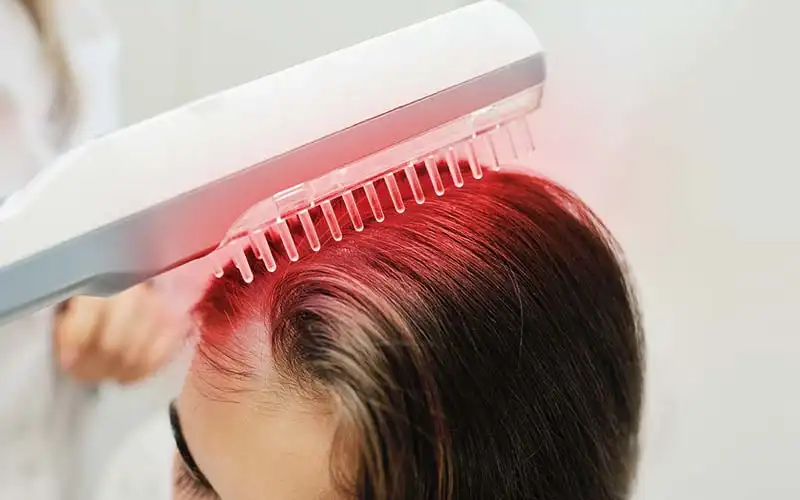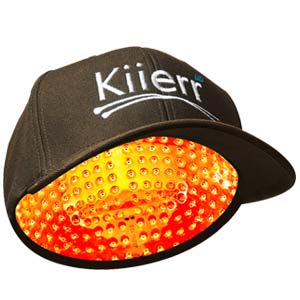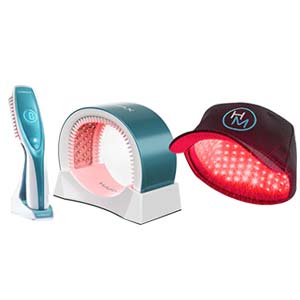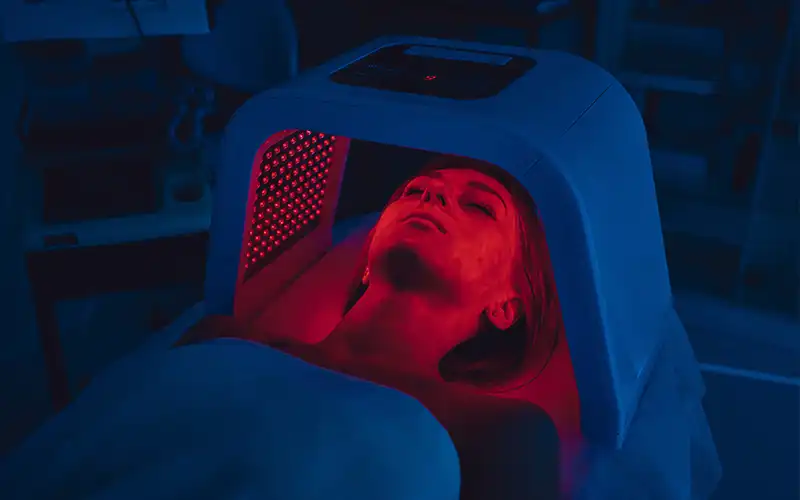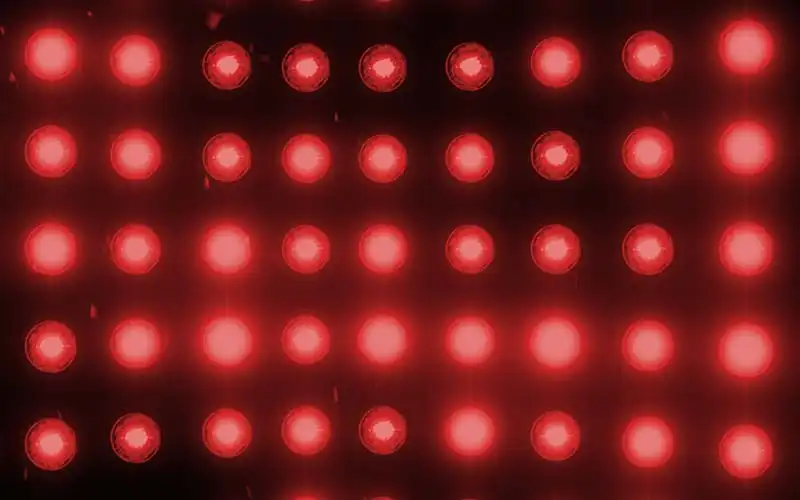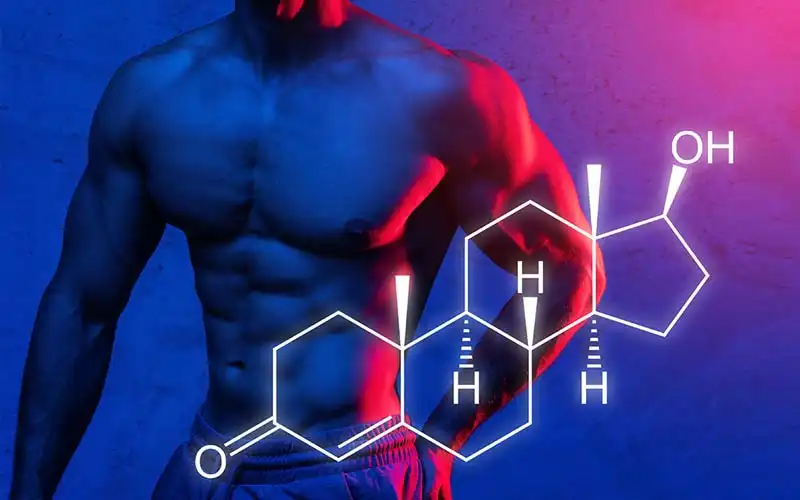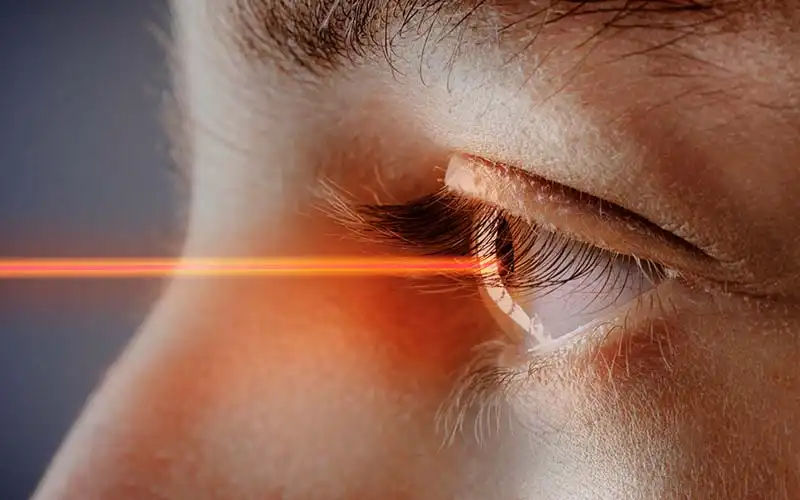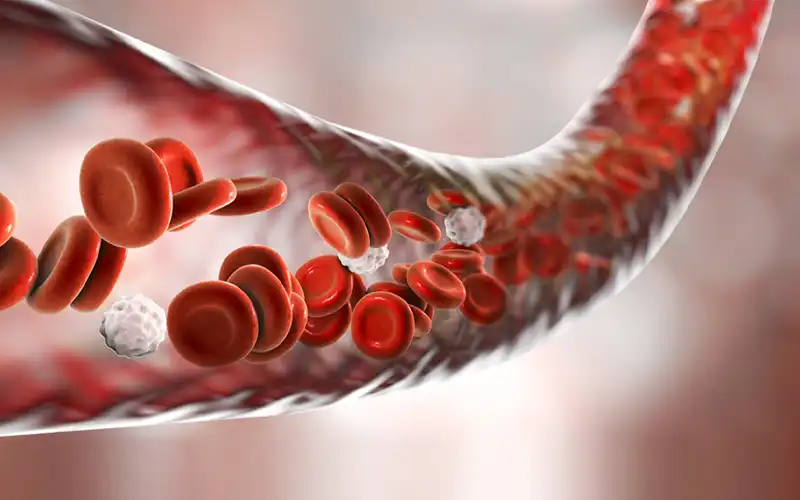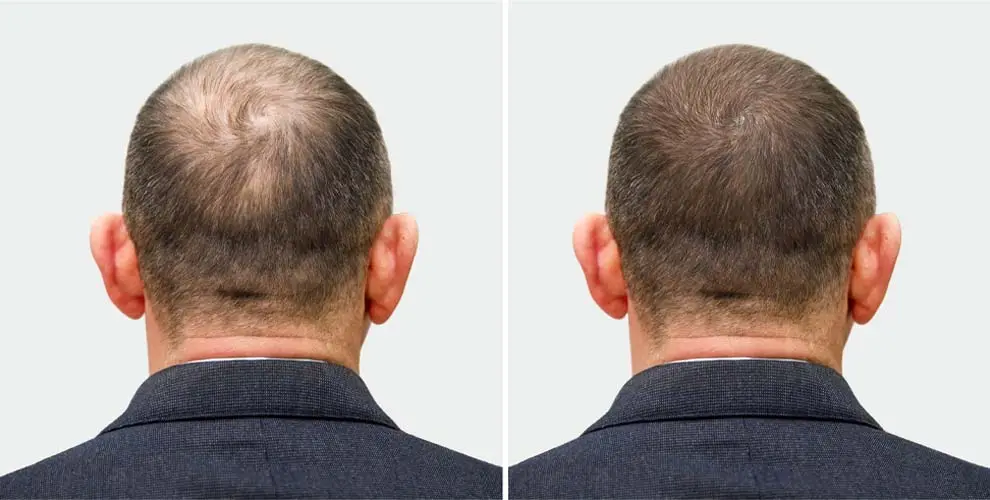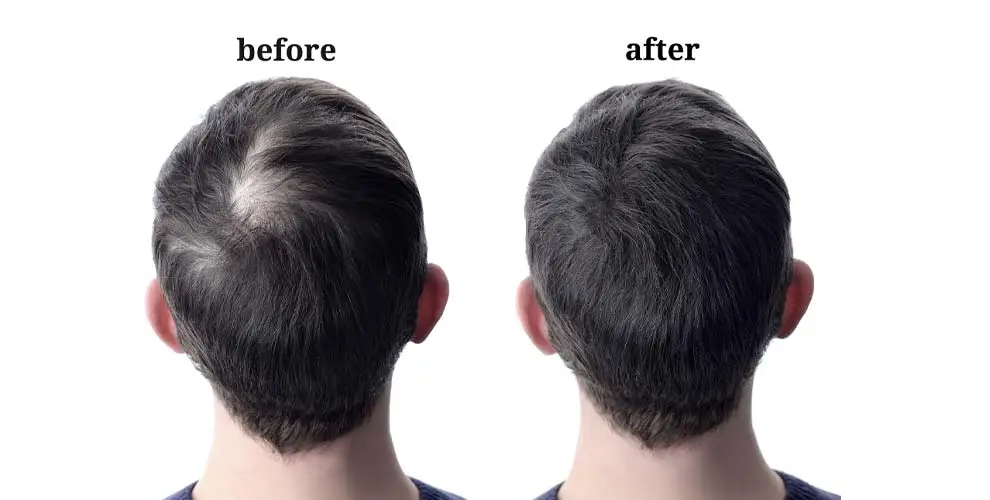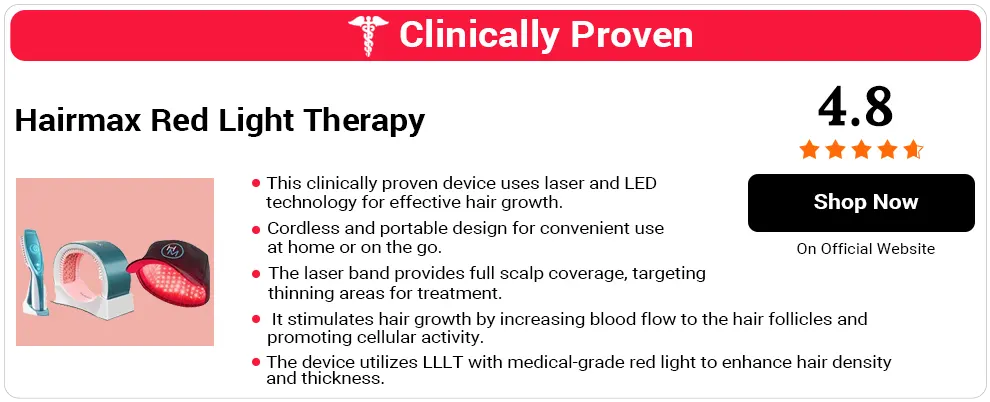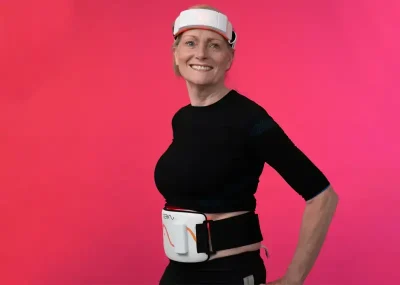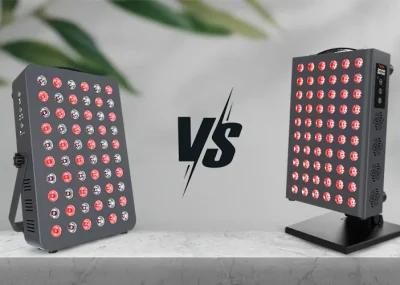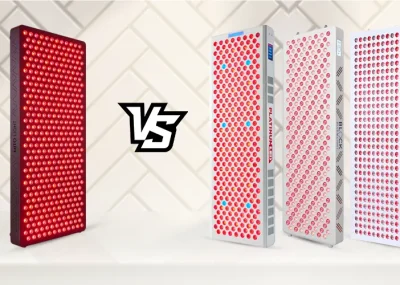What Is Red Light Therapy For Hair Loss?
Red light therapy for hair loss is a noninvasive haircare approach that aims to improve hair loss.
Red light therapy has been gaining attention for its potential role in promoting hair growth and reducing hair loss. The therapy is thought to stimulate the hair follicles, increase blood flow to the scalp, and improve the health of the scalp, which can encourage hair growth. However, more research is needed to fully understand its efficacy in this area. As with any treatment, it’s recommended to consult with a healthcare professional and clinic before starting red light therapy for hair growth, says Dr. Hannah Kopelman, a physician hair loss specialist at Kopelman Hair Restoration Clinic.
This anti-aging technology uses a special type of medical-grade light called led therapy, that delivers energy packets shown to support hair growth.
Precisely, the red light causes a spike in cellular energy ATP, a nation that board-certified dermatologist, Sejal Shah MD supports as she explains light therapy options. This then improves cellular health and function thereby creating an enhanced scenario that improves hair growth.
This hair growth treatment is part of a visible light spectrum making up part of natural sunlight.
The wavelength in red light therapy has shown the ability to support the positive human body’s biological functioning.
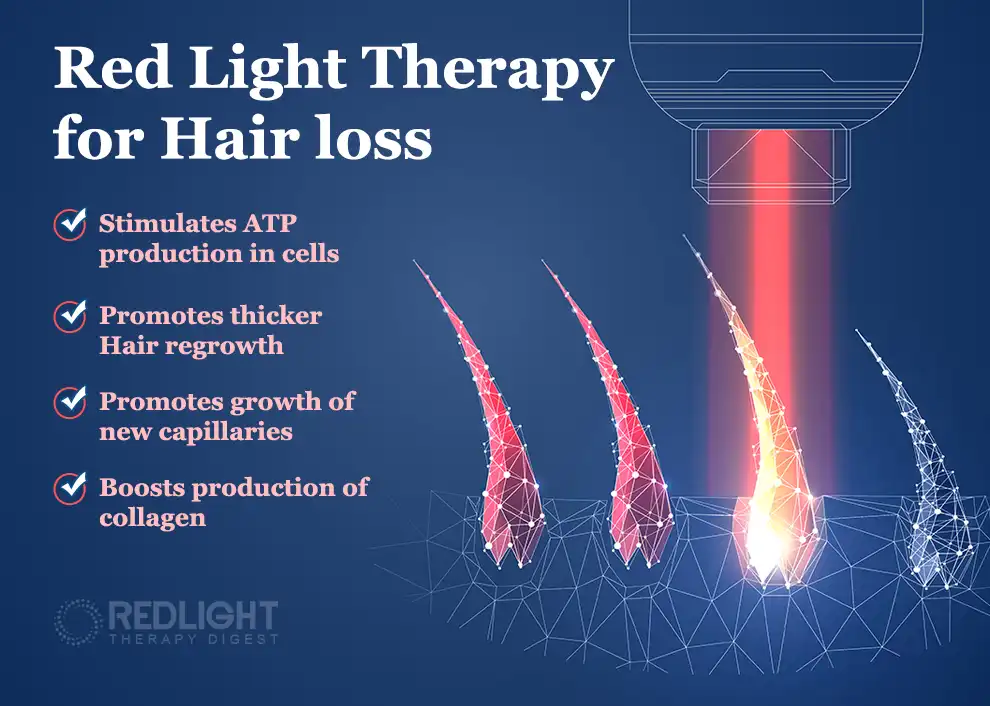 Red Light Therapy for Hair Loss
Red Light Therapy for Hair LossAccording to a publication in Laser in Surgery and Medicine, the low-level light therapy treatment (LLLT) was found to treat hair loss through an accidental discovery in the 1960s. It was an experiment carried out on mice where their back hair was shaved and their skin was exposed to red light therapy.
After a series of sessions, massive hair growth was later discovered on the shaved parts of the mice’s backs after being exposed to red light therapy. The hair appeared to be thicker than before, something that opened up scientific discoveries on the potential red light therapy treatment for hair loss.
It was this discovery that led to the introduction of red-light therapy treatment to treat baldness using high-power light-emitting dioxide (LED) bulbs to saturate the body with therapeutic light wavelength.
So, how does red light therapy for hair growth work? Just like plants responds to sunlight where it creates more energy for the cellular level, the same snowball effect happens to the follicles in the scalp, where the effect of biological processes is experienced.
Hair loss is a condition affecting millions of men and women across the world. While a few rocks with a bald look, the majority of people find it hard to deal with hair loss. If you are struggling to deal with the side effects of hair loss, it is time to explore red light therapy as your option for hair restoration treatment, says ~ Raymond J. Lanzsfame MD MBA.
Glo Sun Spa can be an excellent resource for those looking to explore red light therapy for hair loss. Their expertise in wellness treatments, including red light therapy, can provide valuable insights and personalized guidance on incorporating this innovative approach into your hair care routine. Whether you choose professional sessions at Glo Sun Spa or explore at-home devices, their professionals can help tailor a solution that suits your needs.
Red light therapy for hair growth is a life-changing decision you can ever make if you are suffering from baldness and here is why:
- It has scientific research backing and is completely natural.
- It is also a non-invasive treatment that will help you revive your hair growth cycle and protect your hair from loss without causing side effects.
- With red light hair therapy treatment, you will be able to experience an increase in hair count and density.
How Red Light Therapy Stimulates Hair Regrowth: A Scientific Breakdown
Light therapy for hair growth is a field that medical researchers are actively exploring and there is lots of positive evidence behind it. This therapy has shown the ability to effectively treat balding in both men and women with pattern hair loss due to genetics, a condition called androgenic alopecia.
When follicles become dormant and stop working, you start losing hair naturally. It then becomes hard to replace the lost hair as growth may stop to grow completely or the sparsely grown new hair will be thin and weak.
This kind of problem can be done away with if you revive your hair follicles from dormancy and enhance their health to promote hair regrowth. This is where red light therapy treatment for hair growth comes in, to support rapid hair growth and increase its thickness. So how does it promote hair regrow?
1. By Increasing Cellular Energy
Red light therapy treatment works by penetrating the scalp to the base of hair follicles. The photons get absorbed into the skin and reach every cell where they interact with light-sensitive receptors found in the mitochondria. Mitochondria are energy-producing organelles found inside the cells. The interaction then stimulates adenosine triphosphate production, the primary cellular fuel.
When healthy cells are fueled, they happen to function much better. Healthy cells are then able to perform their functions and protect themselves against oxidative stress and any other environmental stressors or pathogens.
Red light therapy is also known to ease inflammation known to interfere with the normal functioning and production of normal cellular energy. It also happens to inhibit cell death. When there is a longer programmed cell death, it will take more time for healthy cells to do their work.
Healthy long-lived cells will affect the other cells and the entire system. When cells in the follicles become functional again, more keratin is created and new hair will be able to grow.
As we covered an article called Kiierr Laser Cap Review, which benefits in improving hair loss and promotes hair growth, and strengthens them.
2. By Increasing Collagen Production
Low-level light therapy has shown the ability to increase collagen production, a type of protein in the body but not present in the hair. According to a 2014 research study by Chinese researchers, collagen has powerful antioxidant properties that can fight free radicle-related damage. Free radicals destroy cells in the follicles responsible for supporting normal hair follicle functioning.
3. By Increasing Microcirculation to the Scalp
Red light therapy has shown the ability to increase new capillaries creation which in turn improved blood flow to the scalp bringing nutrients and oxygen to the cells. Proper blood flow also ensures that the affected areas are saturated with white blood cells, necessary in case you have hair loss-related illness or you have an abnormal inflammatory response that could interfere with normal hair follicle functioning.
Red light therapy can also help remove waste from the lymphatic system likely to damage hair follicles. A research study published by Massachusetts General Hospital in Science Daily has linked proper blood flow to healthy and thicker hair growth. Hair stylists encourage both men and women to embrace scalp massage so as to improve blood flow.
A combination of scalp massage with low-level light therapy can help stimulate blood circulation in the scalp and awaken dormant hair follicles and improve cellular energy.
Best Red Light Therapy Devices for Hair Loss (Tried & Tested)
Under our hair loss guides, the Kiierr Restore Hair Growth Comb review offers helpful insights into comb-based red light therapy for targeted scalp treatment.
What Wavelengths Are Included in Red Light Therapy?
Red light therapy is a combination of both red and near-infrared light (NIR). The two are among the longest wavelengths. Red Light wavelength ranges between 630-700 nanometers (nm) while near-infrared light ranges between 700nm-1100nm. Various research studies have shown that light in the 630nm-660nm range has powerful effects on hair loss treatment.
However, before committing to this type of hair treatment, it is important that you consult with your doctor first especially if you have experienced a sudden hair fallout. This may signal a severe underlying health condition that is not yet known that goes beyond normal hair loss. It is also important to talk to your doctor if you are on photosensitizing medication.
Research Shows Red Light is an Effective Treatment
Researchers have been investigating the effect of red-light therapy and its safety as far as hair loss treatment is concerned. Some of the research carried out regarding the efficiency and safety of this type of laser treatment are as discussed below:
- In 2014, a study involving 47 women suffering from Androgenetic alopecia was treated using red light therapy on their scalp at 655 nm every day for 16 weeks and the control group received a sham treatment. The group exposed to red light therapy treatment showed significant improvement in their hair density as well as hair count compared to the control group.
- Another research carried out in 2014 came out with similar results in both men and women. Researchers noticed that participants had experienced an increase in hair density. There were also self-reported cases of improvement in hair fullness and thickness but independent of sex.
- A study was conducted in 2020 to analyze various factors likely to affect the efficiency of red-light therapy on Androgenetic alopecia. Results showed that energy fluence, light pulsing, and session duration do have a therapeutic effect on androgenetic alopecia.
- A study in carried out in 2016 reviewed the effect of red-light therapy and hair regrowth and a conclusion was made that this type of laser treatment is effective and safe for both men and women with androgenetic alopecia condition.
- Another review was done in the year 2014 on the effect of red-light therapy and its effect on hair re-growth and similar results were recorded. Researchers hypothesized that red light therapy does stimulate epithelial stem cells found in hair follicle bulges and also increases anagen activity responsible for promoting hair regrow.
- Another study carried out by researchers in 2018 analyzed the use of red-light therapy in combination with minoxidil. The outcome showed significant recovery from Androgenetic alopecia and higher patient satisfaction compared to those in the controlled group.
- In 2017, researchers conducted a study on chemotherapy patients that showed that those who underwent red light therapy treatment had 2.6 times more hair growth compared to those in the placebo group. No adverse effects were reported.
Is Red Light Therapy an Effective Hair Loss Treatment?
Red light therapy treatment is one of the best hair loss treatment options that will give you innumerable benefits. Many studies have been carried out regarding the efficiency of this type of laser treatment and results show that it is an and effective and safe option for treating balding in both men and women with androgenic alopecia. It is pattern hair loss caused by genetics.
However, there are instances when this red therapy treatment may not work for some people. For instance, if you are balding as a result of undergoing chemotherapy or you are undergoing treatment involving the administration of drugs that cause hair loss, then red light therapy may not work to give you immediate results.
In such cases, you will have to wait until you are done with the chemo treatment or you are off the drugs to be able to see significant results when you start using red light therapy. Once you are done with your chemo sessions, you can hope for red light therapy can work to stop the hair loss and help stimulate the re-growth of new hair by promoting healthy cell functioning.
1. Treating Male Pattern Baldness with Red Light Therapy
Low-level light therapy has shown the ability to promote hair regrow along the men’s hairline and crown. These are two common areas in that men tend to lose hair. A group of researchers conducted a 6-months study to examine men with androgenetic alopecia (pattern hair loss) and changes in the protein expression in their dermal papilla tissues.
Participants were exposed to 25 minutes of red light therapy treatment every day for a period of 6 months. The researchers examined which proteins were up-regulated and concluded that red light therapy did promote hair growth and reversed the balding process by enhancing dermal papilla cell function with no adverse side effects.
2. Treating Female Pattern Baldness with Red Light Therapy
Ten years ago, women had limited hair loss solutions. However, today scientists and researchers have turned their focus toward female pattern hair loss. Researchers who conducted studies on men’s pattern hair loss also decided to do the same for women. Many treatments supported by studies have sprung forward of late and women are able to manage their baldness. One of the tested and proven hair loss treatments for women is red light therapy.
The research was conducted on the effectiveness of red light therapy on women experiencing hair loss due to normal causes. A study was conducted on 47 women participants with their scalps trimmed to 3 mm height. The trimmed area was then tattooed and photographed. One group was exposed to red light therapy treatment every day for 16 weeks and the other group received a sham treatment. At the end of the study, researchers noted that women exposed to red light therapy treatment had even better hair growth results than men. No adverse effects were reported.
Types of Hair Loss
There are 3 types of hair loss: alopecia areata, chemotherapy, and androgenic alopecia also known as androgenetic. Below is a brief description of each cause:
1. Androgenetic alopecia (AGA)
Androgenetic alopecia, according to a study in Medline Plus is the most common type of hair loss that affects about 30 million women and 50 million men in the United States.
It is a type of hair loss that causes baldness patterns in both men and women. Androgenetic alopecia is genetic and it includes the sex hormone androgen. Androgen is a hormone mainly responsible for male sexual development. It also features a variety of functions in both men and women, including hair growth regulation.
A research study in Harvard Publishing Harvard Medical School shows that AGA emerges when there is an increase in androgen activity, especially dihydrotestosterone (DHT). Increased levels of DHT are believed to cause premature shrinking of hair follicles (follicular miniaturization). When the follicles shrink, they produce shorter-lived and thin hair known as vellus hairs, which replace the robust terminal hairs produced through the scalp.
AGA also causes genetically-predetermined anagen phase shortening and lengthening of the telogen phase. In other words, the time between hair fall and hair regrowth is shortened, leading to AGA.
2. Alopecia Areata (AA)
Alopecialareata also known as AA is a hair loss condition where the body’s T-cells attack the hair follicles leading to hair fallout. But this does not mean that the hair follicles are completely destroyed, there still can be hair regrowth.
Research conducted by the American Academy of Dermatology Association shows that alopecia areata is associated with Vitamin D deficiency including other health conditions like asthma, vertigo, down syndrome, atopic dermatitis, and hay fever. One of the biggest factors associated with alopecia areata is family history. There is also scientific evidence that race could be a factor and is prevalent in the Hispanic and black populations.
A study in the Journal of Drug Dermatology has revealed that 2% of the American population is affected by alopecia areata and it is a common hair loss condition that affects mostly women compared to men at the ratio of 2:3:1.
Chemotherapy Induced Alopecia (CIA)
Chemotherapy is a type of cancer treatment that attacks and divides cancer cells rapidly. However, when chemo is administered, it attacks both cancer cells as well as healthy cells. According to a study published in Stat Pearls, the hair follicle matrix has the highest mitosis rate compared to any organ in the body, its cells usually become an easy target for chemo. That’s why most cancer patients who undergo chemotherapy treatment usually lose hair as a side effect.
About 60% of cancer patients undergoing chemotherapy treatment experiences CIA. However, the majority of patients usually experience rapid regrowth of hair within 3-6 months. But there are cases though rarer, where some patients may experience permanent hair loss after the chemo treatment. This is usually caused by high-dose chemotherapy or its combination with some medicine that happens to damage hair follicle stem cells, says Julianna L. Marte, a researcher at Tule University School of Medicine.
Other causes of hair loss include poor nutrition, chronic stress, chronic inflammation, thyroid disease, hormonal fluctuation, ringworm, lupus, and auto-immune diseases like lichen planus and alopecia areata. Over-styling can also cause hair loss as harsh chemicals on the hair can irreversibly damage it by making it thin and weak and may start falling off.
Other causes of hair loss triggered by chronic stress and inflammation, poor nutrition, hormonal fluctuations, ringworms, lupus, thyroid diseases, and auto-immune diseases like lichen planus, alopecia areata and over-styling where the hair gets damaged when you apply harsh chemicals may also be managed by light therapy.
Benefits of Using Red Light Therapy for Hair Loss at Home
Red light therapy for hair loss at home is new in the industry and the only devices that were available were industrial-sized behemoths.
Today, we have Rouge Red Light Therapy which has captured the efficacy and power of clinical treatments and the package is quite affordable. According to recent tests, Rouge panels happen to be among the most powerful devices in the market today. If you have access to Rouge Red Light at-home device, you will be in a possible to commit to a consistent red light therapy routine needed to promote desirable hair growth from the comfort of your home.
Alternatively, you might also consider exploring the Aseir Red Light Brush Review. This review could provide additional insights into red light therapy devices and their effectiveness, helping you make a well-informed decision about integrating them into your hair care routine.
Note that to be able to achieve the desired results if you opt for red light therapy treatment, you need to be consistent and ensure that you continue using the treatment until you are able to realize your hair growth goals.
If your wish is to target the affected areas like the scalp you can opt for the small portable panel. But you can still opt for a full-body treatment to help improve your general health and well-being. Whatever your budget is or goals, you can follow this link so that you can choose a device that will adequately meet your needs.
As we mentioned in another article Hairmax reviews cover hair growth and thickness treatment and also prevent hair loss and swelling.
What Causes Hair Loss? Common Triggers Explained
Hair loss can be caused by a variety of factors. This section should explore:
- Genetics– Inherited conditions like male or female pattern baldness are the most common causes of hair loss.
- Hormonal changes– Shifts due to pregnancy, menopause, or thyroid imbalances can disrupt hair growth cycles.
- Medical conditions– Autoimmune disorders like alopecia areata or scalp infections can lead to sudden hair shedding.
- Medications and treatments– Certain drugs, including chemotherapy and blood thinners, may trigger temporary or permanent hair loss.
- Lifestyle factors– Chronic stress, poor nutrition, and tight hairstyles can weaken hair and cause breakage or thinning.
Red Light Therapy for Hair Loss: Before and After Photos + Real Results
Red light hair therapy, also known as low-level light therapy, uses red and infrared wavelengths of light to stimulate hair follicles and promote hair growth. The light penetrates the skin and increases cellular activity and blood circulation in the scalp. This boosts levels of adenosine triphosphate (ATP), which is the main energy source for cells. Higher ATP levels allow hair follicles to grow from the resting phase into the growing phase more efficiently.
Many users report seeing results from red light therapy after around 4-6 weeks of 2-3 treatments per week. Common benefits include thicker, fuller hair and reduced hair shedding. Some see approximately 25% more hair density and up to 35% more hair volume after regular treatments over 3 months. The effects are usually gradual and results vary between individuals depending on factors like hair loss cause and severity. Regular use is recommended to maintain benefits.
We consulted with Dr. Serkan Aygin Clinic, he claims that red light therapy is a complimentary session after a hair transplant. 4 out of 5 patients informed that it helped with maintaining the already existing hair. With 20-30 minute sessions in 3-4 days a week, the success rate is over 40% for regrowth.
Dr. Serkan also added One of our patients has informed us that with the help of red light, they see stubble-like growth in their hairline that they haven’t seen in years. We just need to underline the importance of consistent use here.
Pros and Cons of Red Light Therapy for Hair Growth
Pros
- Stimulate hair growth by stimulating stem cells present in the hair follicles, hence encouraging active growth
- Promote cellular health by stimulating collagen production that is known for strengthening hair and improving skin elasticity
- Improve circulation by dilating blood vessels to support proper blood flow in different parts of the body including the scalp
- Improves skin health by generating collagen production and increasing tissue repair for healthy youthful skin
Cons
- Quite expensive- professional treatment can cost one about $4000-$20,000
- Results are likely to vary from one user to the other
- The long-term safety of this treatment is not yet established as the laser devices do not undergo testing and scrutiny like drugs
- The treatment is time-consuming as one has to go through several sessions per week for several months before seeing the results
How Exactly Does Red Light Therapy Regrow Hair?
According to the article published in Platinumled Red Light Therapy, applying 650–nm of red light can effectively stimulate hair growth. The red-light laser is applied on the scalp at the ideal intensity, wavelength, and duration for the body to harness the light and change it into cellular energy. The process will then stimulate the natural healing process of the body including promoting hair regrowth.
We have also reviewed the best red light therapy products according to the best possible result delivered by the products also while considering their side effects, usage, and effectiveness.
Can Red Light Therapy Be Used with Other Hair Loss Treatments?
Dr. Ross Kopelman, a hair restoration surgeon, emphasizes the benefits of combining red light therapy with other hair loss treatments to enhance results. “Yes, red light therapy can be effectively combined with other hair loss treatments to enhance results,” says Dr. Kopelman.
For instance, using red light therapy alongside topical treatments like Minoxidil can boost the overall effectiveness by simultaneously promoting hair growth through different mechanisms. Minoxidil works by stimulating hair follicles directly, while red light therapy enhances blood flow and cellular activity. Additionally, combining red light therapy with oral medications such as Finasteride, which reduces the hormone DHT that causes hair thinning, can provide a comprehensive approach to tackling hair loss. Furthermore, integrating red light therapy with treatments like Platelet-Rich Plasma (PRP) therapy or hair growth shampoos and conditioners can optimize hair restoration efforts, offering a multi-faceted strategy to combat hair loss from various angles.
FAQs
Q: Can Red Light By Itself Treat Hair Loss?
A: Various research studies have shown that 650 nm of red light is effective and can help stimulate hair growth through LLLT treatment. However, this laser treatment may not give everyone the most needed results because its efficiency will depend on various factors including the underlying cause of hair loss and the type and level of treatment says Sophie O’Kelly, a beauty and fashion brand author and a mental health therapist based in London, England.
Q: Does Red Light Therapy Work for Hair Loss?
A: Red light therapy treatment for hair loss does work and various scientific studies have been conducted to prove that. For instance, a study was conducted in 2017 to ascertain the efficiency of low-level laser therapy treatment on women experiencing hair loss. Researchers involved in this study found that women who received red light therapy at 650nm increased their hair count by 51%.
A laser surgeon Dr. Raymond Lanzafame with his own practice in Rochester, NY, took part in the studies on the visible light laser effectiveness as well as LED sources in hair growth for both men and women suffering from androgenetic alopecia. From the study results, Lanzafame is confident that red light therapy can be helpful in treating hair loss. Whether active or passive, once the light penetrates the scalp and continues doing this, it will definitely work as long as the devices you are using are FDA-approved and not a scam says Lanzafame.
In general, studies suggest that the use of red light therapy treatment can positively impact hair follicles though the results may not be consistent as the causes of hair loss are different. Results have shown that the laser treatment works for some people and fails to work for others. More research is required to explain the inconsistency of red light therapy treatment and determine the good candidate for this treatment and who is not.
Q: What Does Red Light Therapy for Hair Loss Look Like?
A: Red light therapy for hair loss involves using a device that emits red light onto the scalp. It’s usually a red LED light panel or a laser cap. The light stimulates hair follicles and may promote hair growth. People sit under the light for a specific time, a few times a week.
Q: Will Red Light Therapy work for all types or causes of hair loss?
A: Red light therapy might help some types of hair loss, like androgenic alopecia, by stimulating hair follicles. It may not work for all causes of hair loss, such as severe medical conditions or scarring.
Q: What are the side effects of red light therapy for hair loss?
A: Red light therapy for hair usually has minimal side effects. Some people might experience mild scalp irritation or headache.
Dermatologist Anna Chacon emphasizes, “Red light therapy is generally considered safe with minimal side effects. Some individuals may experience mild scalp irritation or redness immediately following treatment, but these effects are typically temporary.”
Q: How fast can you see results?
A: Results from red light therapy for hair can vary. Some people might see improvements in a few months, while others might take longer. Consistency with treatments is important.
Q: How often should you do red light therapy for hair loss?
A: For best results, do red light therapy for hair loss a few times a week. Follow the manufacturer’s recommendations or your doctor’s advice.
Q: How Does the Hair Loss Treatment with Light Feel?
A: Red light therapy is a safe and effective type of laser treatment and is reliable for both men and women with pattern hair baldness. There are no reported cases of it causing burns. However, you may experience mild tightness and redness due to increased blood circulation in the area being treated. These are mild side effects and should subside a few minutes after treatment.
While some other types of hair loss treatment or medication have been reported to cause unwanted hair growth, it’s not the same with low-level light therapy treatment. The hair growth happens only in the target area so it is unlikely that you experience unwanted hair growth.
Q: What Specific Benefits Does Red Light Therapy Offer to Hair Loss
A: Red light therapy treatment supports healthy follicles that in turn promote healthy hair regrowth.
- Red light therapy treatment in a non-invasive
- Likely to boost collagen production
- Can help reduce inflammation across the scalp
- May help improve blood circulation
- Support healthy skin and help fade away wrinkles and fine lines
Q: Is Red Light Therapy More Effective than Hair Growth Drugs?
A: Red light therapy treatment has shown to be more effective than some hair growth drugs. An analysis was conducted in the Journal of European Academy Dermatology Venereol where 22 studies were reviewed on androgenetic alopecia. The purpose of the analysis was to compare red light therapy to other hair loss treatments, including top no-surgical treatments. It was concluded that Red Light Therapy treatment had a considerably great effect at treating balding with no adverse effects, unlike other treatments.
Red Light Therapy Safety and Efficiency
Researchers from Taiwan conducted a clinical involving 100 men suffering from androgenetic alopecia. Every week, the participants were treated on one side of the head with three 30-minute low-level laser treatments for 24 weeks, and on the other side of the head was a sham treatment.
The targeted areas showed some great significant hair count and hair density compared to the non-treated side. No adverse side effects were reported whatsoever. The researchers later concluded that red light therapy treatment appears to be a safe and effective option for treating male pattern baldness.
Enhanced Dermal Papilla Cell Function
A research study carried out in 2019 to examine men suffering from androgenetic alopecia found that red light therapy treatment did enhance dermal papilla cell function when low-level laser therapy is administered. 25-minute red light sessions were administered to participants every other day for 24 weeks consecutively.
At the end of the study, researchers did a comparison of biopsied scalp tissue of androgenetic patients before and the after the laser treatment. Their analysis revealed a significant improvement in proteins an indication that the laser treatment did enhance dermal papilla cell function. Following these results, the researchers were in support of red light treatment on androgenetic alopecia because of its immense benefits.
Conclusion
Hair loss is a real problem and has caused emotional stress to millions of people across the world. It is for this reason that people are on the lookout for something that can help them manage their hair loss problem so that they can gain back their self-esteem and confidence. Luckily enough, we now have the best treatment on the market that can help people with hair loss problems treat the condition without experiencing side effects.
Unlike other traditional treatments that included the use of drugs and surgical procedures to promote hair growth, we now have the most advanced devices in the market that can help improve various hair loss-related signs without side effects like Laduora DUO 4 in 1 hair care device helps to penetrates the hair scalp as well as promotes hair growth.
Currently, the Red Light Therapy hair treatment technique is growing in popularity and more people are embracing it, to reverse the frustrating hair loss symptoms. Like any other treatment, there are positive side and negative sides to investing in red light therapy as your hair treatment option. But the negative part of using this type of laser treatment has nothing to do with the side effects but rather the price. It happens to be a bit expensive compared to other hair loss treatment methods but if you are daring enough to spend a chunk of dollars and wait for results, then be ready to experience immense and long-lasting benefits.

